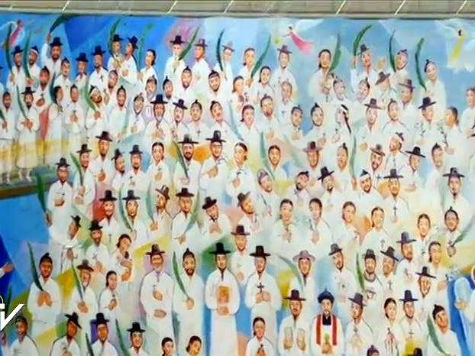Catholicism in Korea came without missionaries, priests or nuns. Instead, it grew from a Confucian scholar who read books about the Faith and was baptized Peter by a Jesuit missionary in China. He returned to Korea with the books and baptized many more, who then did the same.
Incidentally, although priests or deacons now baptize almost all Catholics, the Catechism states:
The ordinary ministers of Baptism are the bishop and priest and, in the Latin Church, also the deacon. In the case of necessity, anyone, even a non-baptized person, with the required intention, can baptize, by using the Trinitarian baptismal formula. The intention required is to will to do what the Church does when she baptizes. The Church finds the reason for this possibility in the universal saving will of God and the necessity of Baptism for salvation.
In 1791, the leaders of the late Joseon Kingdom executed many of Peter’s followers. By the time the first priest arrived, traveling in secret from China in 1794, there were already 4,000 Catholics. In 1888, Korea’s Catholic Church was accorded religious freedom, but waves of persecution claimed 10,000 martyrs, including the Chinese priest and Korea’s first native priest, Father Andrew Kim Taegon in 1846.
Many were drowned, beheaded, buried alive or tortured to death, fates disturbingly similar to the persecution of Christians in the Middle East today.
In 1984, Pope John Paul II traveled to Seoul to canonize the martyrs of 1839, 1846, and 1867. Today, Catholics make up almost 11 percent of the South Korean population, and that number has increased from 1.86 million in 1985 to 5.14 million in 2005.
On Saturday, Aug 16, as part of his Apostolic Journey to South Korea to mark the 6th Asian Youth Day, before a crowd estimated by Catholic News Service (CNA) at 800,000 — out of a population of about 50 million — Pope Francis celebrated an outdoor Mass at Seoul’s Gwanghwamun Gate. During it, he beatified 124 Korean martyrs, putting them at the last step in the process before actual canonization, or sainthood.
In his homily, Pope Francis paid homage to the martyrs and their fidelity to the Faith.
“In God’s mysterious providence, the Christian faith was not brought to the shores of Korea through missionaries; rather, it entered through the hearts and minds of the Korean people themselves. It was prompted by intellectual curiosity, the search for religious truth. Through an initial encounter with the Gospel, he first Korean Christians opened their minds to Jesus. They wanted to know more about this Christ who suffered, died and rose from the dead…
“So often we today can find our faith challenged by the world, and in countless ways we are asked to compromise our faith to water down the radical demands of the gospel and to conform to the spirit of this age. Yet the martyrs call out to us to put Christ first and to see all this world in relation to him and his eternal Kingdom. They challenge us to think about what if anything, we ourselves would be willing to die for.”
Unveiled at the outdoor Mass was a watercolor image of Paul Yun Ji-chung — killed after he buried his mother with Catholic rites, in defiance of his Confucian society — and 123 others, ranging in age from 12 to 75, who had pledged filial piety to God instead of the Korean king.
Among those attending the Mass were 300 U.S. military personnel, and 400 family members of the victims of the Sewol ferry sinking in April.
The Sewol families, including a father who has been on a month-long hunger strike, have been in Gwanghwamun Square protesting for the government to allow an independent investigation into the accident. After days of negotiations, they were allowed to remain for the Mass in hopes of meeting the pope, which some of them did.
CNA also reports that Pope Francis agreed to baptize 62-year-old Lee Ho-Jin, father of one of the victims, who was among a group of Sewol families that met with the pontiff before the Friday Mass for the Solemnity of the Assumption of the Blessed Virgin Mary at the World Cup stadium in Daejon. The baptism is set to take place at the headquarters of the papal nuncio in Seoul on Sunday, ahead of the closing Mass of the 6th Asian Youth Day, at Haemi Castle.
According to the Korea Herald, Lee arrived in Daejon on Friday after making a weeklong walking pilgrimage from his son’s high school in Ansan, southwest of Seoul, stopping on the way at Jindo Island, near where the ferry capsized. Throughout the journey, he carried a 13-pound cross, which he gave to Francis, asking him to take it to Rome, which the pope said he would.
As quoted by CNA, Vatican spokesperson Father Federico Lombardi said that Lee “solicited baptism. Obviously, he is not Christian and that is why he asked for it, but it is clear that he has had preparation with prayer, and with this pilgrimage that he made, we can say he has been on a spiritual journey.”
But the visit is far from over.
On Sunday, Pope Francis meets and lunches with Asian bishops at the Shrine of Haemi, followed by the Mass at Haimi Castle. The visit concludes on Monday, with a meeting with religious leaders at the old Curia Palace of the Archdiocese of Seoul. Pope Francis then celebrates a Mass for Peace and Reconciliation at Myeong-dong Cathedral in Seoul before departing for Rome.
Coverage can be found through video at the Vatican home page, or on satellite and radio network, EWTN.

COMMENTS
Please let us know if you're having issues with commenting.